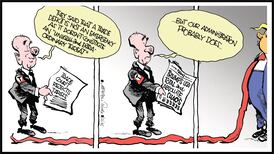SIX DAYS after Eyjafjallajökull’s ash grounded Europe’s air fleets, thankfully three-quarters of them were back in the skies yesterday, some 21,000 of the 28,000 flights normally scheduled. But it will be days, possibly weeks, before the backlog is cleared.
About 100,000 flights have been cancelled, €1.3 billion lost by airlines, €0.8 billion by airports, and hundreds of millions by the hospitality industry. Not to mention the untold misery inflicted on the travelling public. Many will still be travelling for days to get home.
Now the questions are beginning to be asked about what we have learned, whether the authorities were over-zealous and/or slow in their response, and who will pay the bills? Airlines have been questioning the scientific basis for the complete shutdown of airspace, with British Airways chief executive Willie Walsh suggesting a more differentiated approach, allowing some flights, could have been taken from the start.
But the science is not clear. The computer models that guided decisions to impose a no-fly zone are based on incomplete science and limited data and, indeed, may have overstated the risks to the public. It is known that particles of silica in the ash may melt inside engines and cause cooling systems to go down. That, in turn, may close down all engines at once rather than just one or two, an eventuality with which modern jets can cope.
But, crucially, there is an absence of systematic, quantitative research with which to set “safe” levels. Manufacturers have never wind-tunnel tested engines with volcanic ash for what they have regarded as such a rare occurrence. Such tests as have been done have consisted only in the inspection of engines of planes that have flown through ash clouds.
“In the absence of reliable facts, the only thing to do was to stop aircraft from flying, given the risk to planes of suffering serious engine damage, perhaps crashing,” Henri Goudru, a UN scientific adviser and president of the European Volcanological Society, said yesterday. This was not an overreaction.”
In the circumstances resort to the precautionary principle was right and proper. In future, with greater scientific understanding available, a less drastic, more differentiated approach may be possible but the airlines’ bottom line must not be allowed to trump safety.
The issue of financial aid to the cash-strapped airlines is also problematic. On Monday EU transport ministers shelved the issue of state aid until normal service is resumed. Then, in truth, they are unlikely to be much more forthcoming because of stringent EU state aid rules. Others are looking for EU consumer guarantees to be suspended.
Ryanair, for one, appears to have no intention of honouring its obligations to pay the full costs for stranded travellers’ accommodation. The obligation was “turning a crisis into an economic catastrophe”, the group representing budget airlines claimed. Passengers might, however, be more sympathetic to their special pleading that the EU rules were not drafted with such prolonged circumstances in mind were it almost any other airline.







